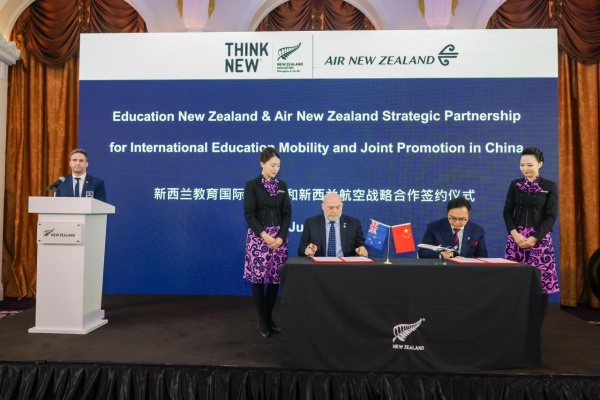Search
Showing 10 of 1867 results for how to register international groups
-
Latest insights on international education
“As we approach the end of 2022, we have an opportunity to take stock, and importantly look forward to next year, one in which we all hope to welcome increasing numbers of international students back to New Zealand,” says Marie Clark, Director Insights at Education New Zealand Manapou ki te Ao (ENZ).
“Despite the long period of border closure there has been only slightly altered demand for international study. Our annual brand tracker shows the New Zealand brand is holding a strong position globally.”
ENZ has been closely tracking the beginnings of recovery. As New Zealand's border reopens, the immediate priority is for international education providers to build back their onshore offerings and attract students back to Aotearoa. The content of this issue is focussed on toward data and analysis related to our initial observations of the sector's recovery.
The Insight Story - Issue 6 includes insights on:
- Student visa applications and Study with New Zealand web stats
- New Zealand's education brand health
- Agent perceptions about international education
- 2021 international student enrolments
- New Zealanders' perceptions of the value of international students
- and more……
Visit IntelliLab to download The Insight Story here.
-
New Zealand Schools Scholarships relaunched in Viet Nam
The 2023 round of New Zealand Schools Scholarships – launched in January – will see 45 scholarships to 45 secondary schools offered exclusively to secondary school students from Viet Nam. Secondary schools from Kerikeri to Invercargill are taking part in what is ENZ’s latest international education initiative in Viet Nam.
This year’s initiative follows the New Zealand Education Fairs in Ha Noi and Ho Chi Minh City in October 2022 that attracted more than 1,000 attendees. The New Zealand – Viet Nam education relationship was also at the forefront of a visit to Viet Nam in November 2022 by former Prime Minister Jacinda Ardern.
Viet Nam is a priority market for New Zealand schools. Pre COVID, the sector saw 80 percent growth in students from Viet Nam between 2017 and 2019. Moreover, nearly a third (28 percent) of all international students from Viet Nam choose to study in New Zealand schools.
ENZ’s Business Development Manager Mary Camp said the New Zealand School Scholarships initiative has attracted quality students with high grade point average and good English language ability to study in New Zealand.
“Vietnamese school students are usually very committed to New Zealand, they stay for several years, experience success, and often pathway to study in New Zealand universities.
“We are delighted to welcome them back to New Zealand and eager for them to experience our quality education in a safe and nurturing environment.”
With relaunching the New Zealand Schools Scholarships for Viet Nam, it was also valuable to have the support of the Schools in International Education Business Association (SIEBA), Camp said.
“SIEBA has been supporting schools by undertaking reference checks in relation to interested education agents, thus reducing the burden on schools and helping them connect with new agents. Activating new agents in Viet Nam will help the entire sector.”
ENZ’s Regional Director – Asia, Ben Burrowes said he was pleased to support the reactivation of the New Zealand Schools Scholarships initiative in Viet Nam.
“ENZ is absolutely committed to its education relationship with Viet Nam and we’re excited to relaunch the New Zealand School Scholarships this year.
“It’s fantastic to see that our international education sector continues to foster strong education ties with Viet Nam, which is demonstrated by the number of schools offering scholarships in 2023.”
Since its launch in 2018, the New Zealand School Scholarships initiative in Viet Nam has grown to become a prestigious, top of mind scholarship for local students.
Celebrating past recipients of the New Zealand School Scholarships

Xuan Khang
Year 13, Pakuranga College
2019 New Zealand School Scholarship recipientXuan Khang came to Pakuranga College in June 2019 and graduated at the end of 2022. He remained in New Zealand throughout the pandemic, and achieved an outstanding academic record. He passed NCEA Levels 1 to 3 endorsed with Merit or Excellence gaining Excellence in both Level 3 Calculus and Chemistry. He was involved in the Academic Council, Environmental Council, the Service Council, the Cultural Council and Peer Support. Xuan Khang won Top Academic International Student at senior prizegiving in 2022 and will study Engineering at the University of Auckland in 2023.
"I came to New Zealand to broaden my horizons and become more independent. I have really enjoyed the practical aspects of working in labs and putting theory into practice. By using English daily, I feel my English has improved to a high standard. I have enjoyed being able to discuss my work with my teachers, who have been friendly and helpful. I feel I have really benefitted from the opportunities provided by living in New Zealand and studying at Pakuranga College."
- Xuan

Ho, Thi My Ha (Ha)
Year 13, Mt Roskill Grammar School
2020 New Zealand School Scholarship recipientHa began her study at Mt Roskill Grammar School in 2020. Intent on success, she achieved ‘Excellence’ endorsements at all three NCEA levels, obtaining 230 Excellence credits even before final exams. This is despite COVID lockdowns, the challenge of online learning, and not being able to travel back to see her family. Her homestay and the Mt Roskill International Department supported her during this time. At the 2022 Senior Graduation, she won the International Student Award, 1st in Level 3 accounting, 2nd in Level 3 Physics, the Hays trophy for Excellence in Commerce and the Lacy Cup for Senior literature.
“My time at Mt Roskill Grammar School was a really fun and helpful experience. One of the things I like most is how helpful everyone is. The teachers and the students are all happy to help and support each other. I also like how different it is from Vietnam because there is flexibility to choose our own subjects and how we learn. We have options about how we study and do exercises, so long as we get the results. There are a lot of extra-curricular activities and opportunities to learn new things.”
– Ha
-
From the CE: India-New Zealand Education Week and release of the Broader Impact Valuation report
As you read this I will be about to get on to a plane to India. I’m leading a high-level University delegation to participate in the India-New Zealand Education Week from 16 - 22 April 2023. This is an important initiative which will further support the sector’s re-engagement with India, a market which remains critical to the recovery of international education.
The week features engagements with institution and Government partners, education agents, media and others involved in both student recruitment and internationalisation. We will also be re-launching the New Zealand Excellence Awards (NZEA), our flagship scholarships programme for India co-funded by Education New Zealand Manapou ki te Ao (ENZ) and all eight universities. The week will be bookended by two ENZ Recognised Agent Fairs in Delhi and Mumbai respectively. I expect it to be successful and enormously valuable.
This is a nice segue to the release of the Broader Impact Valuation report made public for the first time in this edition of E-News. Commissioned by ENZ from EY the valuation found that international education is a significant contributor to the New Zealand economy.
In 2019, international education’s direct financial contribution to New Zealand’s GDP was $3.7 billion using the Computable General Equilibrium (CGE) methodology. The CGE methodology applied by EY to determine the contribution was supported by the Ministry of Business, Innovation and Employment and Ministry of Education and is more rigorous than previous analyses.
Having established the direct financial contribution, EY explored the extent of the indirect longer-term contribution to New Zealand’s GDP from the small proportion of international students that remain in New Zealand after completion of their studies.
EY found that international students living and working in New Zealand in 2019 and 2022 contributed economic, social, cultural, and international benefits. Using Stats NZ Integrated Data Infrastructure (IDI) and CGE modelling, EY found that these students contributed in the order of $6 billion in the form of labour supply and productivity to New Zealand’s GDP in both 2019 and 2022.
Determining this contribution involved estimating the GDP output and wage impacts associated with New Zealand educated international students who remained in New Zealand and transitioned into the domestic workforce in the 10 years leading up to each year.
They also found that the pandemic significantly, and unsurprisingly, reduced the direct financial contribution to an estimated $0.8 billion in 2020. Truly tough times.
From my perspective the report is an important and long-awaited development. Using the most up to date valuation methodology it confirms the contribution the sector has made in the past, the contribution it makes beyond economic value, and tells us that it is possible to become a vibrant, sustainable and resilient sector in the future.
I urge you to download the full report, read it thoroughly and make use of its conclusions within your community.
सहनांशक्तिको वहुशक्ति्तिः
The power of many is greater than the power of one who stands alone.
Ngā mihi nui,
Grant McPherson
-
Around the world in five
Asia
Recruitment fairs resume at China schools
China is resuming in-person recruitment fairs for international universities, with international representatives invited to attend events in person again following the lifting of border restrictions. School education professionals highlight the importance of face-to-face interactions for Chinese families.
North America
Canada: Ontario colleges adopt new standards for programmes and supports for international students
Ontario's colleges have established a new set of standards of practice for international students, including guidelines for marketing and recruitment, education agents, and programme and service delivery, to ensure that international students have access to accurate information and support to succeed in their programmes.
South America
Brazilian outbound market booming in 2023, agents report
Brazilian agents are optimistic for the future with expectations for 2023 to be a record year in outbound travel. Strong demand for teen courses, higher-value sales, shifting requirements from parents, and emerging trends in products and destinations were noted at the ST Alphe Brazil 2023 conference.
Europe
Drastic policy changes ‘could damage’ UK sector
Stakeholders have expressed their concern that if the UK government implements significant policy changes related to post-study work and allowing students to bring their dependants, it could lead to a decrease in the number of international students in the country.
Africa
Regional framework for microcredentials to be developed
Southern African countries are developing a framework for the recognition of learning through micro credentials, with the aim of informing and guiding individual countries and institutions to develop their own country-specific frameworks.
-
International Student Experience Survey 2023 now open
The International Student Experience Survey (ISES) surveys international students and alumni in Aotearoa New Zealand across all international education sub-sectors and at all stages of the student journey – from those who have just arrived in the country to those who have recently graduated.
The ISES aims to better understand the overall international student experience to identify what is being done well, and where improvements can be made.
It features insights and findings on nine, key aspects of the student experience journey –
- Decision making factors
- Study arrangements
- Arrival and orientation experience
- Education experience
- Living experience
- People and connections
- Value for money
- Work experience opportunities, and
- Future plans
The survey targets international students via multiple channels, with the student sample including those on current student visas, post-study work visas, and those post study, but not currently on a work visa. To maximise uptake, ENZ has also engaged with sector peak bodies and education providers to distribute the survey to their students.
Findings from previous surveys have informed ENZ’s Student Experience work, including the development of bespoke content on NauMai NZ that better serves international student needs, shaped student experience-focused outreach across government and informed partnership with community organisations.
ENZ’s Student Experience Manager, Ross Crosson said that the ISES provides a rich data source to understand the student experience.
“Research-informed findings must inform all our mahi. This survey helps us better understand our students’ experience living and studying in New Zealand, which can be used to inform decisions to improve that experience,” Ross said.
“We look forward to sharing survey findings with the sector, and discussing those findings with them, later this year."
-
Around the world in five
Asia
More Tamil Nadu State students from middle class families plump for higher studies abroad
More students from India, including middle-class families, are now eager to study abroad as COVID-19 restrictions ease. Popular courses include engineering, management, and medicine, with countries like the UK, Canada, Russia, and Kazakhstan being preferred destinations. New visa rules in the UK have caused some concern, leading students to consider Australia and New Zealand as alternative options.
North America
Agent role to be reviewed in Canada’s new international education strategy
Global Affairs Canada is concerned about the vulnerability posed by education agents in Canada's international education sector, as they engage in unethical practices that could harm the country's reputation. The upcoming strategy will also prioritize diversification of programs, destinations, and source countries to spread economic benefits more equitably and reduce reliance on specific markets like India and China.
South America
Argentina's agency sector optimistic on future growth
Argentina's outbound study travel sector is optimistic about future growth, with 85% of ARSAA (Argentine Study Abroad Association) members expecting travel in the upcoming quarter. Challenges such as affordable flights, payments, and school communication highlight the need for improved solutions to support Argentine students studying abroad.
Europe
UK to block dependants from accompanying international students as of January 2024
The UK government plans to restrict dependents from accompanying international students, except for those pursuing postgraduate programs with a research focus, starting January 2024. This policy aimed at controlling net migration has sparked worries among prospective students planning to study in the UK.Africa
South Africa's ELT schools hopeful after further recovery in 2022
Education South Africa (EduSA) schools saw a 44.2% increase in international students in 2022, but numbers remained below pre-pandemic levels. Saudi Arabia and Brazil were top source markets, while African markets showed promising growth. The association plans to focus on branding, marketing, and digital development in 2023 to further enhance their international profile.
-
Supporting international education mobility in China with Tourism NZ and Air New Zealand collaboration
ENZ and Tourism NZ Launch the "New Zealand Study Tour Promotion Alliance" Initiative in South China
Tourism New Zealand and ENZ have been working closely together since 2020 to promote study tour programs for Chinese students and their families. This collaboration has had a positive impact, with a growing interest in short-term studies and family tours to New Zealand during the Chinese summer holiday period (this July and August). To further strengthen relationships with Chinese business partners, Tourism New Zealand recently launched the "New Zealand Study Tour Promotion Alliance" initiative, with support from ENZ.

From left to right: Sandy He – South China Manager, TNZ; Rachel Crump – NZ Consul General in Guangzhou; Grace Yao – Regional Trade Manager Greater China; Felix Ye, ENZ Guangzhou
The purpose of the "New Zealand Study Tour Promotion Alliance" is to tap into the potential for growth in this segment post COVID-19. The initiative offers students a short-term study tour experience, providing them with a glimpse into the New Zealand educational system and lifestyle. The alliance consists of ten selected members, including key partners such as K-12 schools and educational organisations directly or indirectly associated with K-12 schools in South China. These members include two provincial-level international education associations representing the public and international school sectors, an international school networking platform, and seven Chinese international/private schools. All ten members of the alliance have either sent students to Aotearoa New Zealand or have committed to promoting New Zealand as a study tour destination in the next three years. They will receive direct or indirect support from both Tourism New Zealand and Education New Zealand.
The official launch of the initiative took place on 21st June, with over 80 participants from the education and tourism industries invited. Rachel Crump, the New Zealand Consul-General in Guangzhou, officiated the ceremony and expressed her excitement about this cross-industry cooperation between Tourism New Zealand and Education New Zealand.
Rachel said “I have often participated in Tourism New Zealand and Education New Zealand events, but this is the first time I’ve participated in a joint event. This type of cross-industry cooperation is new and significant for both agencies.”
Michael Zhang, ENZ's Regional Director - Greater China, also said "As we reconnect following the three years of the pandemic, we invite Chinese students and their families, to come back to New Zealand and become an important bridge between our two countries again.”

Felix Ye, Rachel Crump, and Grace Yao took a group photo with the members of the Alliance
The initiative focuses on promoting a two to four-week New Zealand short-term study experience, which combines classroom study with a sightseeing holiday component. During the Chinese summer holiday, students attend one or two weeks of classroom study in a New Zealand school while their parents enjoy a holiday in the country. After the study part of the tour, families have the option to spend additional weeks in New Zealand. The initiative is expected to attract over 1,000 students plus their families to New Zealand during this July and August Chinese summer holiday period.

After the launch ceremony, the guests mixed and mingled, chatting and networking with each other
ENZ and Air New Zealand to develop strategic partnership for growth of international student sector in China
Education New Zealand Manapou ki te Ao and Air New Zealand have pledged to work together to develop a strategic partnership for the international student sector in China.

ENZ’s Felix Ye moderated the panel discussion with the Alliance members
The initiative was launched with the signing of a Statement of Intent at a special ceremony in Shanghai which was witnessed by Minister of Tourism, Hon Peeni Henare in Shanghai on 30 June during the Prime Minister’s Trade Delegation to China.
Both parties will seek to take advantage of existing cooperation and provide a framework for further potential areas to be developed.
These could include joint promotional and marketing efforts in China, as well as supporting student mobility from New Zealand-China partnerships, joint programmes, and institution to institution co-operation.

ENZ’s Chief Executive Grant McPherson and Air New Zealand’s General Manager – Asia Jonathan Zhang, sign a Statement of Intent at a special ceremony in Shanghai on 30 June during the Prime Minister’s Trade Delegation to China.
-
Around the world in five
Asia
Ten higher education institutions (HEIs) in the Philippines have partnered with Chinese institutions, in a bid to boost collaboration and partnership in the fields of science, technology, agriculture and mathematics. The partnerships were signed during the Philippines-China University President Cooperation Dialogue, which took place during China-ASEAN Education Cooperation Week.
North America
An escalating diplomatic row between Ottawa and New Delhi has the potential to deter thousands of Indian undergraduates from studying in Canada. More than 40% of the 800,000 international students in Canada in 2022 were from India, making it the largest source country for overseas learners. Academics warn that if the rift grows, it could have devastating consequences for student mobility.
Middle East
Hundreds of United Arab Emirates students are expected to seek higher education admission and career guidance from more than 30 international universities participating at the Study Abroad Education Fair held by Charms Education. Students will be able to network with admissions representatives, alumni, and fellow applicants as they explore options across Canada, the United Kingdom, Germany, and more.
Europe
Global pathway provider Navitas has expanded its presence in Europe with the announcement of a new partnership with SRH Universities Germany. Navitas said that international students looking to study in Germany will have more options available following the five-year deal, which will include the establishment of an International College at the SRH University Heidelberg campus.
Africa
As the window allowing international students to bring relatives along with them to the United Kingdom closes gradually, the hopes of many Nigerian graduates planning to do their post-graduate programmes in the United Kingdom are fading slowly ahead of the 2024 deadline. Data shows that around 100,000 Nigerians travelled abroad to study in 2020 and many observers have projected that figure to be on rise. With the recent announcement, many have had their hopes dashed.
-
Learn New Every Day – new global brand campaign launched to attract international students to New Zealand
The new campaign called Learn New Every Day, delivers a student’s point of view of the first-time experiences international students could encounter in a single day when they study with New Zealand.
ENZ’s General Manager of Marketing and Communication, Geoff Bilbrough, said that 'Learn New Every Day’ is designed to cut through in a very competitive market.
“We wanted to capture the essence of what it is really like to study with New Zealand, taking the perspective of a learner as they encounter new experiences, and convey the excitement and emotion as they go through their day.
“What makes the campaign more memorable is its high energy, positive, contemporary feel. And the first-person point of view approach is unique to the category,” Geoff said.
Geoff went on to say, “The scenes and scenarios in the campaign reflect our core values of a high-quality education and employability/future opportunities. These messages are woven through the campaign through imagery and action involving learners in a range of environments across all parts of New Zealand’s education sector, alongside the well-known adventure and social experiences. The featured imagery reflects what we know international students are looking for in a New Zealand education.”
Learn New Every Day was pre-tested and performed well in in-depth one-on-one interviews with students and parents from China, South Korea, India, and Viet Nam. Feedback was also sought from across New Zealand’s international education sector, who also responded positively to the concepts, their relevance to the young learner, and the clarity of the idea.
ENZ’s Global Brand Manager, Nick Sinclair, said that the campaign involved a mix of current international and domestic students from primary, secondary, and tertiary institutions.
“We had a wonderful time interacting with the international students while capturing these ‘first-experience’ scenes. They were really excited about the opportunity to take part in the decision-making process for other students and their parents as they choose their overseas study destination.
“The campaign communicates what we strongly believe is New Zealand’s competitive edge in the international education market. A New Zealand education experience is as much about the adventure, social experiences, and our unique culture and landscapes, as it is about the high-quality study opportunities that we offer”.
The campaign will run for at least 18 months. It is running initially in China, India, South Korea, Thailand, Viet Nam, and Japan targeting students aged 16 to 24 and their parents across all sectors including high school, university, Te Pūkenga, English language schools and private training establishments. Campaign assets include videos of various lengths, digital banners, and assets for the creation of off-line collateral such as banners, and other materials, in English and the local languages of our target countries.
As well as featuring across paid digital media in these countries, the campaign features on all 10 Study with New Zealand websites, in all communications with prospects that sign up to Study with New Zealand, and across all other ENZ channels.
All images and other campaign collateral can be found on ENZ’s Brand Lab here - Home | Education NZ Brand Lab | The ENZ Brand Lab
For media enquiries contact:
Stephanie Morison,
Senior Communications Advisor
Education New Zealand Manapou ki te Ao
+64 223020104, Stephanie.morison@enz.govt.nz
-
Marketing toolkits
On this page are links to a number of toolkits that you may find helpful as you look to market your education institution to international students.
Also, included are some toolkits to help you raise the profile and benefits of international education here in New Zealand.
Digital Boost
This is a free self-directed online learning platform, packed with short videos, live events and expert advice to help you grow your business and thrive in today's digital world. https://digitalboost.business.govt.nz/s/?language=en_NZ
NZ Story Toolkit
On this website, you will find free resources including images, footage, brand videos, infographics, presentations, research and how-to-guides to promote New Zealand offshore. New Zealand Story | New Zealand Story Group (nzstory.govt.nz)
Social Licence Toolkit
Check out ENZ's communications toolkit that helps you tell stories about the benefits of international education to New Zealanders. The significant impacts of COVID-19 mean international education needs increased public support to rebuild and recover, so it can help our country to do the same. By using unified messaging and telling shared stories, we can create a new international education story that captures the hearts and minds of the New Zealand public. Communicating the benefits of international education - toolkit | ENZ IntelliLab
Brand Lab
The ENZ Brand Lab is a rich source of images, videos and other marketing tools to help our industry partners promote New Zealand education. Home | Education NZ Brand Lab | The ENZ Brand Lab

